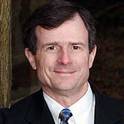
On lattices whose bonds are assigned time delays from a bimodal distribution with modes at b and a≫b whose relative weights are p and 1-p, the dependence of the first-passage velocity v on p is investigated by means of scaling arguments and computations. As p increases, v exhibits a sharp rise near the percolation threshold due to a crossover from the contact-propagation regime, in which slow-bond crossings are rate limiting, to the chemical-propagation regime, in which the tortuosity of the shortest path through the fast-bond network is rate limiting. Previous analyses of criticality in the limit a/b→∞ are extended by obtaining corrections to scaling for finite a/b. The qualitative picture is confirmed by small-cell real-space renormalization-group (RSRG) computations, and proposed scaling laws for critical exponents are tested by means of large-cell Monte Carlo RSRG computations and by a computational method analogous to the transfer matrix for conductivity. The development is analogous to the well-known theory of the conductivity of a disordered medium, and in fact corresponds to a particular limit of the nonlinear conductivity problem. This correspondence, in conjunction with the proposed scaling laws and a duality argument, is exploited in order to evaluate critical exponents governing two-dimensional superfluid flow. Scaling arguments developed here are shown to be applicable also to stirred percolation, leading to a new scaling law for the conductivity of stirred-percolation systems.

Published by the American Physical Society in Physical Review B
http://link.aps.org/doi/10.1103/PhysRevB.33.3353
Publisher PDF is available for download through the link above.